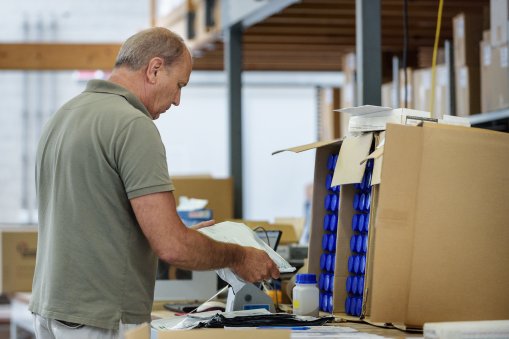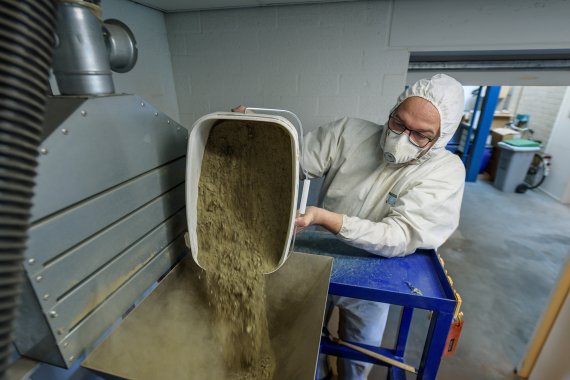Powdering
Wepal makes uniform soil samples in three main steps. Fred Bransen first breaks up and powders the dried, rough soil in the ‘jaw crusher’ and the ‘cross-beater’. The result is a powdery substance.
Photos Guy Ackerman
The Nergena greenhouses can be found at the end of the Bornsesteeg. The building nextdoor houses Wepal and Quasimeme, two relatively little-known Wageningen University & Research institutes, which guarantee the quality of chemical analyses in laboratories. About 700 laboratories all around the world are in close contact with Nergena by post. Postal services are key to the ring test provided by the institute.
In the ring test, identical samples are sent to participating labs around the world. An average is taken of the results that are sent back, and this provides the consensus value. Any lab deviating too far from that is not doing it right. So the ring of participating labs always establishes the norm itself. A lab that deviates from the norm too often can lose its accreditation.
Soil and sea
Ring tests have come into existence because of the need to compare analysis results better worldwide, explains Winnie van Vark of Wepal (Wageningen Evaluating Programs for Analytical Laboratories). ‘Previously everyone just used to do their own thing. That’s why the idea grew up: let’s all analyse the same sample and see what comes out of that.’ The nice thing about a study like that is that everyone is free to use their own technique. As long as the result is the same. Wepal, which is 60 years old now, does ring tests with samples of soil crops, fertilizer and biomass. Wepal’s younger sister Quasimeme – an acronym for Quality Assurance of Information for Marine Environmental Monitoring in Europe – does the same thing with samples of seawater, sediment and fish. The organization started nearly 25 years ago as an EU project in the Scottish city of Aberdeen, and moved to Wageningen in 2004. Wepal and Quasimeme have since merged to form one organization.
Exactly the same
The store at Nergena is full of cardboard boxes containing soil samples. Labels like Terneuzen, Elbe, Liverpool, Wadden and Venice give away their origins. Not that origin is very important. The crux of a good ring test is that every participant gets the exactly the same. Equal treatment: that is the art which these institutes have perfected over the years. It is a question of drying, milling, mixing and homogenizing so that every lab get exactly the same sample in their test tube (see photos).
Homogenizing
The powder is mixed in a cement mixer and then spread over a large surface layer by layer in parallel lines. The result is a carpet of ten thin layers of powder divided over 14 lines. Slices of this go into a funnel and are caught by Fred Bransen in pots he has ready.
The basis of a good soil sample is that it is natural. In principle, pollution is not added later. Van Vark: ‘The substance you are studying can start interacting with the rest of the soil. To prevent that, it is important that the samples you send around are as close as possible to the samples normally analysed by the labs. What I would really like would be to have a collection of all European soils.’
Mussels
At Quasimeme it is customary to ‘spike’ the samples, adding the substances to be detected, says Steven Crum. A particular way of spiking is currently being trialled. Crum and his colleagues will be feeding mussels with powdered stinging nettles over the next few weeks. This is a more or less controlled way of poisoning the creatures with PAKs, PCBs and other chemical pollutants. The reason they are doing this is interesting: it is hard to find mussels polluted in this way in the Netherlands. Crum: ‘Dutch coastal waters have simply become too clean.’
Crum did not actually make the samples for Quasimeme in Nergena, but in the Environmental risk assessment lab in the cellar of Lumen. ‘With mercury measurements, for example, you’re looking at nano quantities. In which case you need to be able to work in a pretty much dust-free environment. That is not possible at Nergena.’

Posting
‘Postman’ Peter Pellen puts pots of soil samples into plastic envelopes. Four pots per delivery: three different samples plus a pot whose contents are known, as a control. The envelopes are posted by ordinary mail. They don’t need to go registered mail because they are worthless in themselves.
Another striking difference from Wepal is that water samples are sent in a frozen state. This is necessary so as to prevent material from breaking down. Crum packs his samples in polystyrene boxes with coolpacks cooled to -80 degrees Celsius. ‘In these they say frozen for 72 hours. That is just long enough to be able to send them by courier service.’ The ring test providers give these services good custom. Crum: ‘We spend 15 to 20 thousand euros a year on courier services.’

